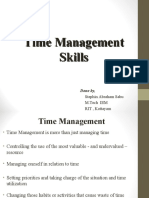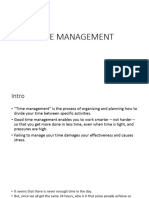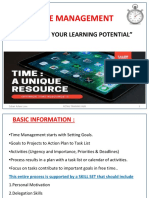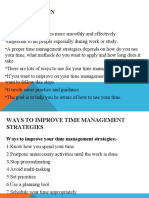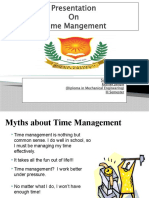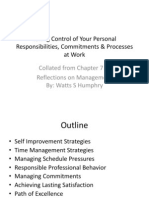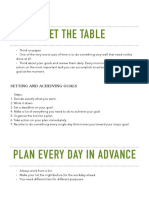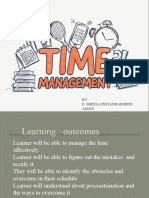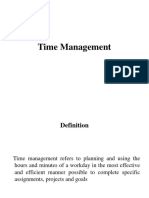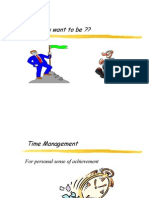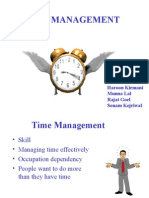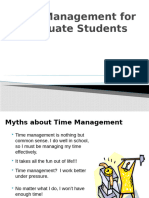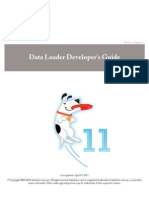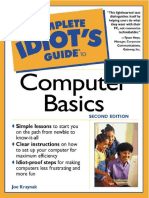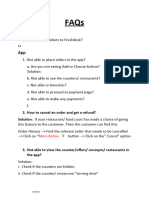Time Management
Time Management
Uploaded by
aarti.takawaneCopyright:
Available Formats
Time Management
Time Management
Uploaded by
aarti.takawaneCopyright
Available Formats
Share this document
Did you find this document useful?
Is this content inappropriate?
Copyright:
Available Formats
Time Management
Time Management
Uploaded by
aarti.takawaneCopyright:
Available Formats
Time Management
Aarti Takawane
Time Management
Methodology
Time Management Implies
Appreciating Value of Time
Treating it as a Resource
What Time Management
Allows You ?
Eliminate time wastage.
Reduce excessive workloads due to mismanagement.
Ensures that important task is not missed out due to time
constraint due to lack of focus
Ensures that important task is completed first
Allocate resources appropriate to a tasks importance.
Ensure that long-term requirements are not neglected while
focus is on short term priority.
Plan each day, week, month or quarter efficiently.
Allows you that work missed today should be planned
tomorrow on top priority
Helps you to achieve your target
Time Management
Efficient
Successful
Relaxed
Healthy
makes you :-
Common Obstacles
Unclear objectives
Disorganization
Inability to say no..to what
you can not do
In-ability to delegate trying to do every
thing yourself
Common Obstacles
Interruptions by phone calls, mobile
phone has made it even worse
Interruptions by people, meeting
unexpected people
Periods of inactivityspending too much
of time in leisure or watching excessive T.V
etc,
The Urgent/Important Matrix (I)
Managing time effectively, and achieving the things that
you want to achieve, means spending your time on things
that are important and not just urgent.
IMPORTANT: These are activities that lead to the achieving your
goals and have the greatest impact on your life.
URGENT: These activities demand immediate attention, but are
often associated with someone elses goals rather than our own.
DO NOW
Emergencies, complaints and crisis issues
Demands from superiors or customers
Planned tasks or project work now due
Meetings and appointments
Reports and other submissions
Staff issues or needs
Problem resolution, fire-fighting, fixes
Subject to confirming the importance and the urgency of
these tasks, these tasks need doing now.
Prioritize tasks that fall into this category according to their
relative urgency.
If two or more tasks appear equally urgent, discuss and
probe the actual requirements and deadlines with the task
originators or with the people dependent on the task
outcomes.
Help the originators of these demands to re-assess the real
urgency and priority of these tasks.
Dealing with the activities
in Quadrant 1
Know your schedule
Prioritizing in a logical way
Be as productive and effective as possible.
Look for ways to break a task into two stages if it's an
unplanned demand
PLAN TO DO
planning, preparation, scheduling
research, investigation, designing,
testing
networking relationship building
thinking, creating, modelling,
designing
systems and process development
anticipation and prevention
developing change, direction,
strategy
These tasks are most critical to success, and yet commonly
are the most neglected.
Include planning, strategic thinking, deciding direction and
aims, etc., all crucial for success and development.
Plan time-slots for doing these tasks, and if necessary plan
where you will do them free from interruptions.
Break big tasks down into separate logical stages and plan
time-slots for each stage.
REJECT AND EXPLAIN
Trivial requests from others
Apparent emergencies
Ad-hoc interruptions and distractions
Misunderstandings appearing as complaints
Pointless routines or activities
Accumulated unresolved trivia
RESIST AND CEASE
'Comfort' activities, computer games, net surfing,
excessive cigarette breaks
Chat, gossip, social communications
Daydreaming, doodling, over-long breaks
Reading nonsense or irrelevant material
Unnecessary adjusting equipment etc.
Embellishment and over-production
Habitual 'comforters' not true tasks. Non-productive, de-
motivational.
Minimise or cease altogether. Plan to avoid them.
Goal Setting
Setting SMART Goals
Goal setting is critical to effective time management
strategies.
Goal setting can be used in every area of your life.
Setting goals puts you ahead of the pack!
Some people blame everything that goes wrong in their life
on something or someone else.
Successful people dedicate themselves towards taking
responsibility for their lives, no matter what the unforeseen
or uncontrollable events.
Setting SMART Goals
Goal setting is critical to effective time management
strategies.
Goal setting can be used in every area of your life.
Setting goals puts you ahead of the pack!
Some people blame everything that goes wrong in their life
on something or someone else.
Successful people dedicate themselves towards taking
responsibility for their lives, no matter what the unforeseen
or uncontrollable events.
The Three Ps
Setting meaningful, long-term goals is a giant step toward
achieving your dreams. In turn, setting and achieving short-
term goals can help you accomplish the tasks you'll need to
achieve the long-term ones. It is also important to make sure
that all of your goals unleash the power of the three P's:
POSITIVE
PERSONAL
POSSIBLE (REALISTIC)
The SMART Way
SMART is a convenient acronym for the set of criteria that a
goal must have in order for it to be realized by the goal
achiever.
SPECIFIC
MEASURABLE
ACHIEVABLE
RELEVANT
TIMED
Achieving challenging goals requires a lot of mental energy.
Invest your mental focus on one goal, the most important
goal right now.
Choose a goal that will have the greatest impact on your life
compared to how long it will take to achieve.
A large part of goal setting is not just identifying what you
want, but also identifying what you must give up in your
life in order to get it.
Prioritize your work by urgency of the task:
1. Needs to be done now
2. Should have been done yesterday
3. Should be done today
4. Can wait until tomorrow
5. Can wait until time permits
After prioritizing your work by urgency, it should then be
prioritized by the date it was received.
Say no, followed by an honest explanation.
Say no and then briefly clarify your reasoning without making
excuses.
Say no, and then give an alternative.
Empathetically repeat the request in your own words, and
then say no.
Say yes, give your reasoning for not doing it, and provide an
alternative solution.
Provide an assertive refusal and repeat it no matter what the
person says.
Critical Path Method is an effective and powerful method of
determining:
Tasks which must be carried out
Where parallel activity can be carried out
The shortest time in which a project can be completed
Resources needed to achieve a project
The sequence of activities, scheduling, and timings involved
Task priorities
A logical sequencing of a series of events necessary for a successful
research project.
A list of all activities required to complete the project
The dependencies between the activities
The estimate of time (duration) that each activity will take to completion.
Activity: Hanging a picture
We need to define and list all the tasks that have to be done, so that the
whole project is completed.
Choose a place on the wall
Buy the screws
Choose the picture
Drill a hole
Screw in the screws
Hang the picture
Procrastination means delaying a task that should be a
priority.
It is important to overcome procrastination and tackle the
important actions that have the biggest positive impact in
your life.
I am a great believer in luck, and I find the harder I work, the
more I have of it - Thomas Jefferson
No clear deadline
Inadequate resources available
Dont know where to begin
Task feels overwhelming
No passion for doing the work
Fear of failure or success
1. DELETE IT.
2. DELEGATE.
3. DO IT NOW.
4. ASK FOR ADVICE.
5. CHOP IT UP.
6. OBEY THE 15 MINUTE RULE.
7. HAVE CLEAR DEADLINES.
8. GIVE YOURSELF A REWARD.
9. REMOVE DISTRACTIONS.
Crisis Handling
With better planning, improved efficiency, and increased
productivity, the number of crises you encounter should
decline.
However, you cant plan for everything, so in this module well
look at what to do when a crisis does occur.
In a crisis, be aware of the danger, but recognize the
opportunity - John F. Kennedy
Handling Crisis
Dont wait until crisis hits to put a crisis management plan
together.
Respond in a timely manner The more you wait, the more
damage can be done.
Be quick, but be factual.
Select a primary spokesperson to represent the organization
throughout the crisis process.
All communications (press releases/statements) should go
through one channel you dont want the media going to
other sources for information.
Handling Crisis
Assign a designated back-up spokesperson to step in should
the primary spokesperson be unavailable.
Never say No comment (it implies guilt) or speak off the
record (there is no such thing).
Discuss whether the crisis calls for a video response by the
primary spokesperson to give it a more human touch.
Express empathy and concern when victims are involved
you dont want to deflect blame and come off as insensitive
and uncaring.
Dont bury bad news It will get out eventually.
Entrusting responsibility and authority to others who then
become responsible to us for their results but we remain
accountable to our boss what our subordinates do.
The right to make decision
Not merely the passing downwards of work
STRATEGY - A
you ask to get facts
you decide what action to take
instruct to respond accordance with you solution
STRATEGY -B
Ask to investigate and deal with the issue
as they consider
as long as customers grievance is resolved and
the customer is tied more closely to your company than
was before
Organizing Your Workspace
In order to effectively manage your time and
to be productive each day, you must create
an appropriate environment.
By eliminating clutter, setting up an effective
filing system, gathering essential tools, and
managing workflow, you will be well on your
way to creative an effective workspace.
The only thing
even in this
world is the
number of
hours in a day.
The difference
in winning or
losing is what
you do with
those hours.
Woody Hayes
To retrieve materials quickly, youll need an effective filing
system that includes three basic kinds of files:
WORKING FILES
REFERENCE FILES
ARCHIVAL FILES
Once clutter has been eliminated and other materials have
been filed, the effective workspace includes only what is
essential: a set of three trays to control the workflow on your
desk (see the next topic), standard office supplies, a
computer, and a telephone.
DO: If a task can be completed in two minutes or less, do it
immediately.
DELETE: If the material is trash or junk, delete it. Or, if its
something that you might use later on, file it, and move on.
DEFER: If the task is one that cant be completed quickly
and is not a high priority item, simply defer it.
DELEGATE: If a task is not yours to do, then delegate it.
Remember, to take the S.T.I.N.G. out of feeling
overwhelmed about a task, follow these steps:
Select one task to do at a time.
Time yourself using a clock for no more than one hour.
Ignore everything else during that time.
No breaks or interruptions should be permitted.
Give yourself a reward when the time is up.
Open and read urgent e-mails and respond accordingly. Non-
urgent e-mails can be read later. Delete e-mail that you have no
interest in.
Create folders for different topics or projects, or by senders.
Most e-mail systems also allow you to create folders and add
keywords or categories to messages.
Many e-mail programs allow you to create rules that
automatically move messages to the appropriate folder. This can
help you follow your e-mail plan.
Finally, dont forget to delete e-mail from your trash can and
junk folder on a regular basis.
A calendar is the obvious place to record meetings,
appointments, and due dates.
For people with multiple responsibilities, an annual calendar
organized by areas of responsibility may be especially
valuable.
For each of these areas, one can list the major responsibilities
month by month and thereby see glance what tasks must be
completed in a given month of the year.
Systems like Microsoft SharePoint, Wrike, Pelotonics,
Google Docs, and Basecamp can give users interaction and
collaboration tools from any location.
These sorts of tools may be most beneficial for project
meetings or situations where users need to peer review
each others work.
You might also like
- Time Management SkillsDocument17 pagesTime Management SkillsKj NaveenNo ratings yet
- Lecture On Time Managment 2021 Lecture IIDocument27 pagesLecture On Time Managment 2021 Lecture IIkennedychipote0No ratings yet
- Time Management by Zubair Aslam LoneDocument21 pagesTime Management by Zubair Aslam LoneMISSION 2025No ratings yet
- Basic Principle of ManagementDocument38 pagesBasic Principle of Managementextcengg4uNo ratings yet
- Time Management JKMDocument300 pagesTime Management JKMRadhi MusaNo ratings yet
- Time-Management UpdatedDocument35 pagesTime-Management UpdatedAbdullah RockNo ratings yet
- Time Management: Until We Can Manage Time, We Can Manage Nothing Else. Peter DruckerDocument27 pagesTime Management: Until We Can Manage Time, We Can Manage Nothing Else. Peter DruckerSakshi BansalNo ratings yet
- Time Management: Minal Jobanputra Look For Me On Twitter @minaljobanputra Face Book LinkedinDocument61 pagesTime Management: Minal Jobanputra Look For Me On Twitter @minaljobanputra Face Book LinkedinMinal KatiraNo ratings yet
- Study Skills Time Management UnisaDocument21 pagesStudy Skills Time Management Unisafakad15966No ratings yet
- More Time - More Work - More SuccessDocument10 pagesMore Time - More Work - More Successgexayal944No ratings yet
- Time ManagementDocument16 pagesTime ManagementAman NiranjanNo ratings yet
- 3001 Week 2 Time ManagementCERT FLMDocument46 pages3001 Week 2 Time ManagementCERT FLMVenus RichNo ratings yet
- Time Management: Biju SomanDocument40 pagesTime Management: Biju SomanAnenas BalanNo ratings yet
- Time Management: Winnie M. Pineda Maris N. CombesDocument64 pagesTime Management: Winnie M. Pineda Maris N. CombesArcee Ardiente Mondragon100% (1)
- Time ManagementDocument16 pagesTime ManagementRhea AgulayNo ratings yet
- Time Management For Your PHDDocument18 pagesTime Management For Your PHDVeniceLiNo ratings yet
- Time Management 1Document23 pagesTime Management 1video songNo ratings yet
- 1440 Minutes in A Day: Managing Your Time: Presented by Michele Guerra, MS, CHES Director UI Wellness CenterDocument22 pages1440 Minutes in A Day: Managing Your Time: Presented by Michele Guerra, MS, CHES Director UI Wellness CenterShailja SharmaNo ratings yet
- Time Management: Compiled By: Biju SomanDocument39 pagesTime Management: Compiled By: Biju SomanBalachandar RamamurthyNo ratings yet
- Lecture 5Document32 pagesLecture 5Winter SnowNo ratings yet
- Time ManagementDocument17 pagesTime ManagementShubhojit ChattopadhyayNo ratings yet
- Time Management 3 NewDocument23 pagesTime Management 3 NewMount Saipal International AcademyNo ratings yet
- Trainer's NotesDocument19 pagesTrainer's NotesaadthilNo ratings yet
- Taking Control of Your WorkDocument26 pagesTaking Control of Your WorkarunkapaniaNo ratings yet
- Slide Six PM BbaDocument10 pagesSlide Six PM BbasumayaNo ratings yet
- Set The Table: Setting and Achieving GoalsDocument7 pagesSet The Table: Setting and Achieving GoalsTejaswiniNo ratings yet
- Time Management 1Document27 pagesTime Management 1Shubham dattatray koteNo ratings yet
- Time Management 1Document27 pagesTime Management 1Sathis KannanNo ratings yet
- Time ManagementDocument21 pagesTime ManagementKirtiNo ratings yet
- Time Management For Graduate StudentsDocument24 pagesTime Management For Graduate StudentsJesse NgNo ratings yet
- Time Management Skills For Employees: MR V.Muniraju NaiduDocument18 pagesTime Management Skills For Employees: MR V.Muniraju NaidumuniNo ratings yet
- Put First Things First: Delivered By: Leela Ram, Arun, Megha and Bidyut Adopted From: Book by Stephen R CoveyDocument27 pagesPut First Things First: Delivered By: Leela Ram, Arun, Megha and Bidyut Adopted From: Book by Stephen R CoveyMallikarjun ChakinalaNo ratings yet
- Time MGMT PPT, 26.05.12Document34 pagesTime MGMT PPT, 26.05.12Sunil Pulikkal100% (1)
- Successful Time Management SkillsDocument18 pagesSuccessful Time Management SkillsLinda HillmanNo ratings yet
- Myths About Time ManagementDocument23 pagesMyths About Time ManagementJesse NgNo ratings yet
- Presentation On Time Management - 1Document19 pagesPresentation On Time Management - 1Chaudhary Ekansh PatelNo ratings yet
- Time Management 1Document27 pagesTime Management 1Nine ToNo ratings yet
- DelegationDocument72 pagesDelegationFaheem AkhtarNo ratings yet
- Time ManagementDocument19 pagesTime ManagementSahil PawarNo ratings yet
- Module Five WorksheetsDocument3 pagesModule Five WorksheetsGaurav BishtNo ratings yet
- ESSP A2 SolutionsDocument11 pagesESSP A2 SolutionsCST A69 Trisha NandyNo ratings yet
- Time Management: Group5 Ankush Bhandari Haroon Kirmani Munna Lal Rajat Goel Sonam KejriwalDocument39 pagesTime Management: Group5 Ankush Bhandari Haroon Kirmani Munna Lal Rajat Goel Sonam KejriwalSonam KejriwalNo ratings yet
- Time ManagementDocument12 pagesTime ManagementChiduruppa Shrynika ReddyNo ratings yet
- Time ManagementslidessDocument23 pagesTime ManagementslidessSana Hamdani100% (1)
- Time Management: Jaipuria Institute of Management, LucknowDocument26 pagesTime Management: Jaipuria Institute of Management, LucknowRahul VermaNo ratings yet
- Reading Day MaterialDocument30 pagesReading Day Materialxuv700awdNo ratings yet
- Time Management SeminarDocument18 pagesTime Management SeminarFaith CayetanoNo ratings yet
- OB Session 5Document21 pagesOB Session 5D GhoshNo ratings yet
- Effectivetimemanagement 131124102712 Phpapp02Document29 pagesEffectivetimemanagement 131124102712 Phpapp02Eric JanhomNo ratings yet
- Time ManagementDocument35 pagesTime ManagementJahangir AliNo ratings yet
- 3 - Time Management MDDocument36 pages3 - Time Management MDAbrar SayedNo ratings yet
- Time Management 1Document27 pagesTime Management 1sidrahmukhtarNo ratings yet
- Swami Keshvanand Institute of Technology, Management and Gramothan, JaipurDocument10 pagesSwami Keshvanand Institute of Technology, Management and Gramothan, JaipurVritikachandelNo ratings yet
- Secrets Time Management Job SuccessDocument17 pagesSecrets Time Management Job SuccessiukhanNo ratings yet
- Time ManagementDocument23 pagesTime ManagementshwetabhatnagarNo ratings yet
- Crticial Thinking-Decision Making-Problem SolvingDocument12 pagesCrticial Thinking-Decision Making-Problem SolvingAlexei GallardoNo ratings yet
- Faiza - 1241 - 19700 - 6 - Faiza - 1241 - 19700 - 1 - Lecture 2 - Time ManagementDocument29 pagesFaiza - 1241 - 19700 - 6 - Faiza - 1241 - 19700 - 1 - Lecture 2 - Time ManagementMuhammad NafayNo ratings yet
- Time Managment and Leadership NotesDocument8 pagesTime Managment and Leadership NotesSahil Dahat100% (1)
- Workplace EtiquetteDocument13 pagesWorkplace Etiquetteaarti.takawane100% (1)
- Work CultureDocument23 pagesWork Cultureaarti.takawaneNo ratings yet
- Body Language & GesturesDocument50 pagesBody Language & Gesturesaarti.takawaneNo ratings yet
- Body Language & GesturesDocument50 pagesBody Language & Gesturesaarti.takawaneNo ratings yet
- Revo Uninstaller User's ManualDocument27 pagesRevo Uninstaller User's Manualathen257No ratings yet
- CA - 165 - IX - Assignment Chapter 4Document4 pagesCA - 165 - IX - Assignment Chapter 4PrinceNo ratings yet
- Computer Test g8Document5 pagesComputer Test g8Ibaka MalamboNo ratings yet
- Part 1 Computer Software Application ModuleDocument56 pagesPart 1 Computer Software Application ModuleJenny Mae OrillaNo ratings yet
- Bigbelly Station Data Sheet 1802 - HC5Document4 pagesBigbelly Station Data Sheet 1802 - HC5diego83777No ratings yet
- Azpen A727 Tablet User GuideDocument20 pagesAzpen A727 Tablet User GuideMetalBreathNo ratings yet
- OpenText Media Management 16.3 - Administration Guide English (MEDMGT160300-AGD-EN-02) PDFDocument306 pagesOpenText Media Management 16.3 - Administration Guide English (MEDMGT160300-AGD-EN-02) PDFdustinbrNo ratings yet
- Sales Force Data LoaderDocument41 pagesSales Force Data LoaderhertzelNo ratings yet
- UCM User GuideDocument318 pagesUCM User GuideimarichardsNo ratings yet
- Work Instruction For CLEAN UP of SOSTDocument11 pagesWork Instruction For CLEAN UP of SOSTssambangi555100% (1)
- One DriveDocument120 pagesOne DriveganeshNo ratings yet
- The Complete Idiot's Guide To Computer Basics, 2nd EditionDocument457 pagesThe Complete Idiot's Guide To Computer Basics, 2nd Editionfrankjg_20100% (3)
- DESKTOPDocument21 pagesDESKTOPyleno_meNo ratings yet
- Speak-Philkorja: An Android Based Language Tutorial Application 2 - 1Document55 pagesSpeak-Philkorja: An Android Based Language Tutorial Application 2 - 1Zeny MolinaNo ratings yet
- Hadoop Dev - HDFS Trash - Hadoop DevDocument5 pagesHadoop Dev - HDFS Trash - Hadoop Devnilesh86378No ratings yet
- Recovering Deleted and Wiped Files A DigDocument10 pagesRecovering Deleted and Wiped Files A DigIon PopescuNo ratings yet
- Analyst - PPG Notes-RevDDocument33 pagesAnalyst - PPG Notes-RevDnevoscientificNo ratings yet
- Finder Shortcuts MACDocument3 pagesFinder Shortcuts MACStevenNo ratings yet
- Unit 6: Operating SystemDocument66 pagesUnit 6: Operating SystemNasarMahmoodNo ratings yet
- Remove METROPOLITAN POLICE Ransomware (Uninstall Guide)Document53 pagesRemove METROPOLITAN POLICE Ransomware (Uninstall Guide)John RapleyNo ratings yet
- 999+ Keyboard ShortcutsDocument13 pages999+ Keyboard Shortcutsaamer141No ratings yet
- Windows 7 and File Management: Section 1Document7 pagesWindows 7 and File Management: Section 1Prima IntrusianoNo ratings yet
- GeneralDocument12 pagesGeneralharithapulagamNo ratings yet
- SAP Navigation GuideDocument69 pagesSAP Navigation GuidersholdingsNo ratings yet
- UNIT 5 Avid Xpress DV 4Document22 pagesUNIT 5 Avid Xpress DV 4S. JirilinNo ratings yet
- GB Assessment Test (Gbat) : #Covid-19. Stay Safe, Stay EducatedDocument9 pagesGB Assessment Test (Gbat) : #Covid-19. Stay Safe, Stay EducatedJASON50% (2)
- Unit 1 English For ITDocument22 pagesUnit 1 English For ITJose MiguelNo ratings yet
- System IdentificationDocument23 pagesSystem IdentificationSantiago Garrido Bullón100% (3)
- Windows Keys On A Mac KeyboardDocument5 pagesWindows Keys On A Mac KeyboardGurvansh SinghNo ratings yet
- Practical ICT MaterialDocument116 pagesPractical ICT MaterialIsaac B PhiriNo ratings yet
